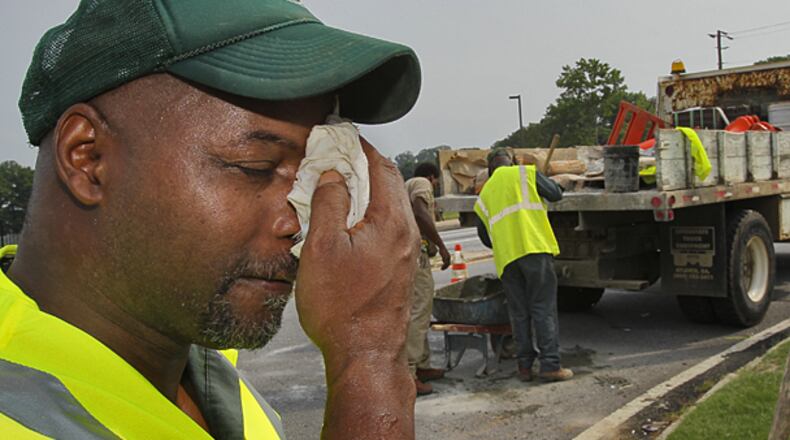On Monday, my virtual assistant warned me of a heat advisory in effect in metro Atlanta.
On Tuesday, the thermostat in my car registered 108 degrees.
On Wednesday, I took the dog out at 7 a.m. and got a breath of fresh, hot air, thanks to a record high morning temperature.
With heat indexes in the 100-to-109-degree range across metro Atlanta and other parts of the state, we experienced what some news outlets have called the hottest week of the year.
I had the luxury of spending most of my time working in air-conditioned buildings, but I thought a lot about all the people who had no choice but to work in blistering heat: the UPS drivers, the garbage collectors, the farm workers, the construction crews and the landscapers.
An average of 40 workers each year die from heat, according to the most recent data from the U.S. Bureau of Labor Statistics. But that figure doesn’t measure all the deaths in which heat may have been a factor.
Public Citizen, an advocacy group based in D.C., estimates annual fatalities from heat exposure are closer to 2,000 workers while there are about 170,000 heat stress related injuries in the U.S.
Yet, there are no federal regulations that protect workers who are toiling in extreme heat.
Research on federal standards for heat safety was completed back in 1972. But it wasn’t until nearly 50 years later, in 2021, that the Occupational Safety and Health Administration (OSHA) announced its intent to develop heat-specific regulations. That’s a process that can take years more.
If you trust climate change models, or just your own sense that something is amiss, you know that our coolest years are behind us. Workers need enforceable protections now.
Some states – California, Minnesota and Washington – have developed their own OSHA-approved standards for protecting workers from scorching heat. Georgia, routinely ranked among the hottest states in the country, has not. Texas recently went in the opposite direction, with laws that limit municipalities from intervening on workers’ behalf.
With no state or federal protections, people working in conditions of extreme heat are left to rely on the benevolence of their employers. Or to file a complaint with OSHA.
Recently, UPS and the Teamsters Union signed a five-year contract that includes protections for employees working in high temperatures. But it took the looming threat of a strike. New trucks will be equipped with air conditioning while old trucks will get fans. In the past, UPS resisted outfitting trucks with air conditioning, deeming it unfeasible since workers make frequent stops. Temperatures in the trucks have been recorded at well over 100 degrees.
Other industries are fine-tuning their arguments against possible federal regulations. Groups representing farming, forestry and other outdoor industries have emphasized the need for employee training rather than OSHA regulations.
In a letter sent from the National Cotton Council of America to OSHA during the public comment period, a representative said many heat related issues are not the result of the agricultural work or employer mismanagement, but our 21st century lifestyle: “Present day luxuries such as air conditioning is present in most all American households and public facilities making it more difficult to face the severe change in temperatures to move from a cool dwelling or vehicle to the heat of a field. While age certainly plays a part, you can find many farmers that have discovered that younger workers, who are used to a more sedentary lifestyle, cannot last a day working outside.”
With last week’s heat wave, OSHA sent out a press release reminding employers to help prevent heat illness.
“By law employers are responsible for providing workplaces free of known safety hazards, including extreme heat,” it read. The document also detailed responsibilities of employers, such as providing workers with water, rest and shade and allowing returning or new workers to gradually acclimate to working in the heat. Employers should also have a plan for emergencies, train workers on prevention and monitor workers for signs of illness.
The agency said it is planning enhanced enforcement – more inspections, more enforcement tools – particularly in areas where workers are clearly in danger.
“Employers should immediately take all steps to protect workers from extreme heat,” the release read.
OSHA should do the same.
Read more on the Real Life blog (www.ajc.com/opinion/real-life-blog/) and find Nedra on Facebook (www.facebook.com/AJCRealLifeColumn) and Twitter (@nrhoneajc) or email her at nedra.rhone@ajc.com.
About the Author
The Latest
Featured


